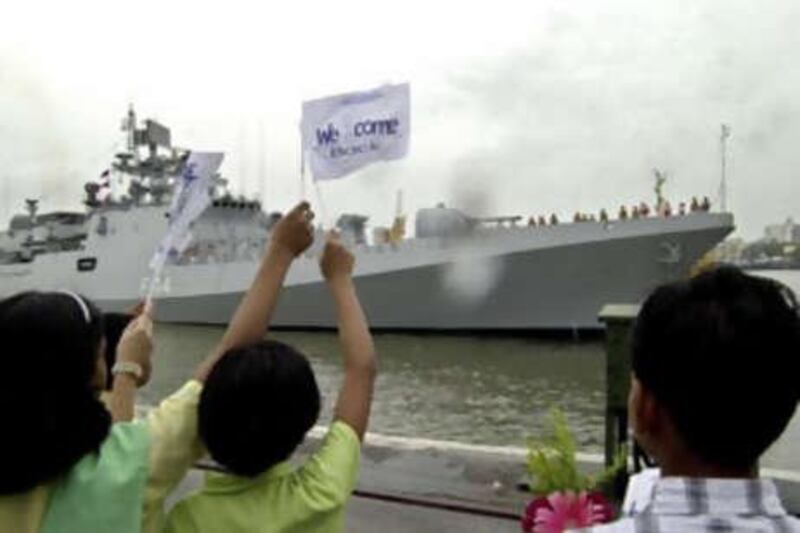When the Sirius Star and its US$100 million crude oil cargo and 25 crew were hijacked by Somali pirates nine days ago, one country was ready to respond immediately. After Indian shipowners and seafarers' unions outlined the pirate threat, New Delhi moved with laserlike focus. The navy dispatched a warship to the region in mid-October, and its personnel have in recent weeks foiled three attempted hijackings and sunk a pirate mother ship - the only country to do so.
The Somali pirates have wreaked havoc - increasingly so - in the Gulf of Aden and along the coast of Somalia in recent months. Piracy in the region has tripled this year, according to the International Maritime Bureau, with more than 120 attacks resulting in 40 hijackings, hundreds of hostages and at least seven dead crew. Estimates of Somali pirates' 2008 ransom income range from $30 million (Dh110m) to $150m.
A recent rash of brazen attacks has upped the ante. The Sirius Star hijacking took place 830 kilometres from the coast of Kenya, meaning the pirates have put all area shipping routes at risk. Feeling the heat, major shipping firms - including the world's largest carrier, Copenhagen-based AP Moller-Maersk - have begun diverting liners away from the area, even though the alternative route around the Cape of Good Hope means millions in extra costs.
Analysts estimate up to half a billion dollars in lost shipping revenue this year. Yet news reports highlight the pirates' shiny mansions, advanced weaponry and hi-tech gadgets. The international community appears baffled, responding with concern but minimal focus. Most agree that a long-term solution involving the establishment of a stable Somali government could take up to a decade. About short-term responses there has been no such consensus. In a hastily arranged meeting with its neighbours, Egypt tried last week to forge a joint regional antipiracy strategy - but to no avail. The United Nations has authorised asset freezes and travel bans, despite the fact that Somali pirates live off cash ransoms dropped from helicopters. Nato has dispatched several warships, but like the United States and the European Union, points out that it has no jurisdiction to attack hijacked ships. The possibility of attacking pirate ships is rarely addressed. The United States has been particularly feeble. Last week the US navy told shipping companies to ensure their own security by hiring private contractors. Yet over three years ago Adm Michael Mullin, now chairman of the Joint Chiefs of Staff, suggested a global security partnership to tackle maritime piracy and terrorism. The only result is the US-run Global Fleet Station, a pilot version of which was launched last year in the Caribbean, suggesting the United States is either living in the past or watching too many movies. Contrast all this with the confident clarity coming from India. Last week the Indian government authorised hot pursuit of pirate vessels, announced the imminent dispatch of three more warships and a reconnaissance aircraft and urged the United Nations to orchestrate joint action. The International Maritime Bureau has praised India's response and urged the international community to follow it. India has been facing down piracy since making maritime history with the rescue of a Japanese vessel from pirate hands in the Arabian Sea in 1999. Indian frigates escorted US warships headed to Afghanistan through the pirate-infested Malacca Straits in 2002. And after the devastating 2004 tsunami as well as after Cyclone Nargis struck Myanmar this year, Indian ships were first to deliver aid and relief supplies. Yet last week's missions marked a sea change - the first time the Indian navy had fired shots in anger so far from home. The world's largest democracy has long sought to transform its economic growth into military and diplomatic might, and is in the process of acquiring the hallmarks of a naval power - aircraft carriers and nuclear submarines. These recent manoeuvres, 2,900km from its shores, represent a more aggressive stance, an effort to exert control over the waters from Djibouti to Indonesia - a stretch of open and not-so-open sea through which 20,000 commercial vessels and crucial regional energy supplies pass each year. Paired with a successful moon landing this month and the recently completed civilian nuclear deal with the United States, India's anti-pirate aggression is the act of a rising world power seizing the opportunity on a floodlit stage. A welcome stance, indeed, but tackling Somali piracy will take a great deal more. "The only solution I see is a co-ordinated effort by various naval forces," said Fred Burton, an analyst with Stratfor, a US-based risk assessment agency. "The problem is that no single country wants to take the lead." In the past couple of weeks, India has done just that, but its lone-wolf aggression will not end the threat. A UN Security Council draft resolution that calls upon capable navies to dispatch armed vessels and combat the menace would be a good first step. But whether the international community is ready to follow India's lead and take on Somali piracy with the seriousness it deserves remains to be seen. The National






